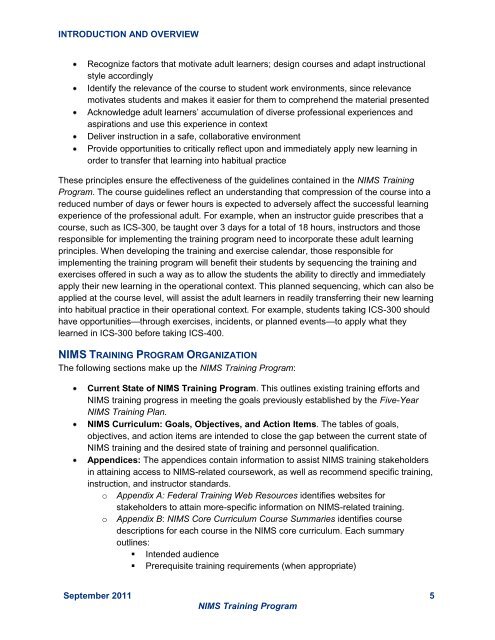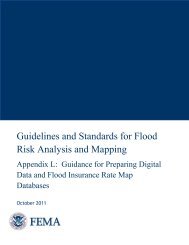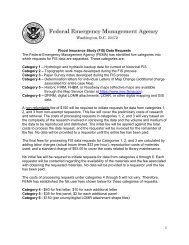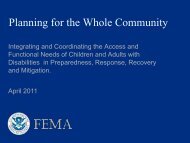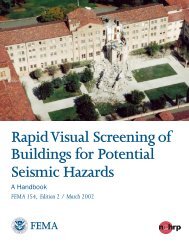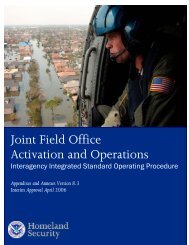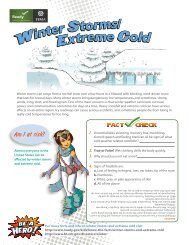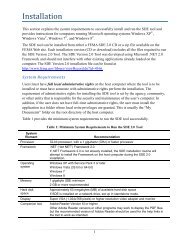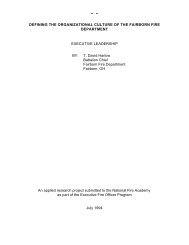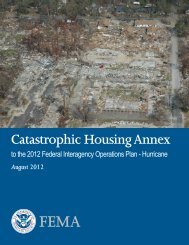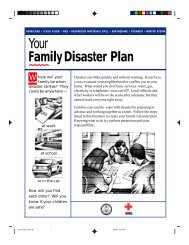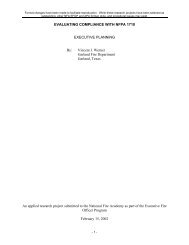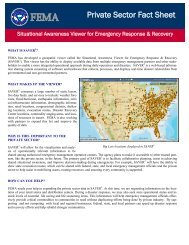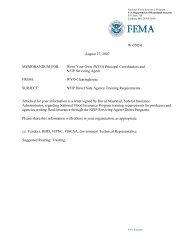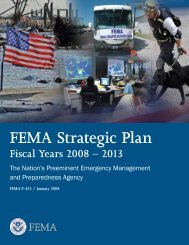NIMS Training Program - Federal Emergency Management Agency
NIMS Training Program - Federal Emergency Management Agency
NIMS Training Program - Federal Emergency Management Agency
You also want an ePaper? Increase the reach of your titles
YUMPU automatically turns print PDFs into web optimized ePapers that Google loves.
INTRODUCTION AND OVERVIEW<br />
Recognize factors that motivate adult learners; design courses and adapt instructional<br />
style accordingly<br />
Identify the relevance of the course to student work environments, since relevance<br />
motivates students and makes it easier for them to comprehend the material presented<br />
Acknowledge adult learners’ accumulation of diverse professional experiences and<br />
aspirations and use this experience in context<br />
Deliver instruction in a safe, collaborative environment<br />
Provide opportunities to critically reflect upon and immediately apply new learning in<br />
order to transfer that learning into habitual practice<br />
These principles ensure the effectiveness of the guidelines contained in the <strong>NIMS</strong> <strong>Training</strong><br />
<strong>Program</strong>. The course guidelines reflect an understanding that compression of the course into a<br />
reduced number of days or fewer hours is expected to adversely affect the successful learning<br />
experience of the professional adult. For example, when an instructor guide prescribes that a<br />
course, such as ICS-300, be taught over 3 days for a total of 18 hours, instructors and those<br />
responsible for implementing the training program need to incorporate these adult learning<br />
principles. When developing the training and exercise calendar, those responsible for<br />
implementing the training program will benefit their students by sequencing the training and<br />
exercises offered in such a way as to allow the students the ability to directly and immediately<br />
apply their new learning in the operational context. This planned sequencing, which can also be<br />
applied at the course level, will assist the adult learners in readily transferring their new learning<br />
into habitual practice in their operational context. For example, students taking ICS-300 should<br />
have opportunities—through exercises, incidents, or planned events—to apply what they<br />
learned in ICS-300 before taking ICS-400.<br />
<strong>NIMS</strong> TRAINING PROGRAM ORGANIZATION<br />
The following sections make up the <strong>NIMS</strong> <strong>Training</strong> <strong>Program</strong>:<br />
Current State of <strong>NIMS</strong> <strong>Training</strong> <strong>Program</strong>. This outlines existing training efforts and<br />
<strong>NIMS</strong> training progress in meeting the goals previously established by the Five-Year<br />
<strong>NIMS</strong> <strong>Training</strong> Plan.<br />
<strong>NIMS</strong> Curriculum: Goals, Objectives, and Action Items. The tables of goals,<br />
objectives, and action items are intended to close the gap between the current state of<br />
<strong>NIMS</strong> training and the desired state of training and personnel qualification.<br />
Appendices: The appendices contain information to assist <strong>NIMS</strong> training stakeholders<br />
in attaining access to <strong>NIMS</strong>-related coursework, as well as recommend specific training,<br />
instruction, and instructor standards.<br />
o Appendix A: <strong>Federal</strong> <strong>Training</strong> Web Resources identifies websites for<br />
stakeholders to attain more-specific information on <strong>NIMS</strong>-related training.<br />
o Appendix B: <strong>NIMS</strong> Core Curriculum Course Summaries identifies course<br />
descriptions for each course in the <strong>NIMS</strong> core curriculum. Each summary<br />
outlines:<br />
� Intended audience<br />
� Prerequisite training requirements (when appropriate)<br />
September 2011 5<br />
<strong>NIMS</strong> <strong>Training</strong> <strong>Program</strong>


